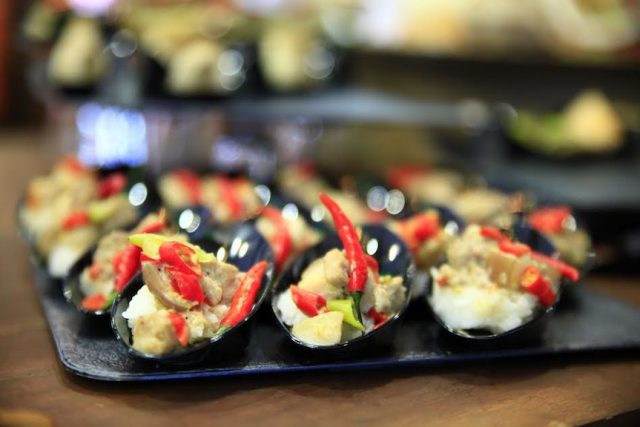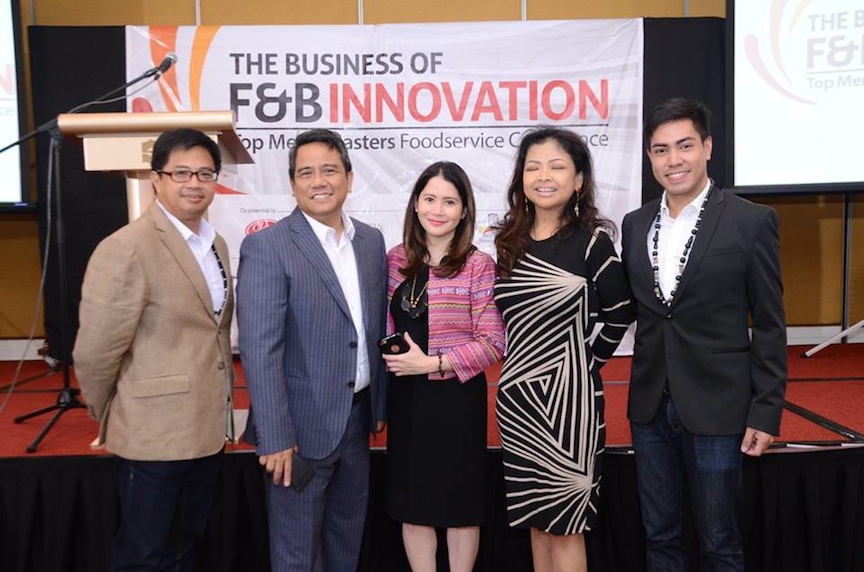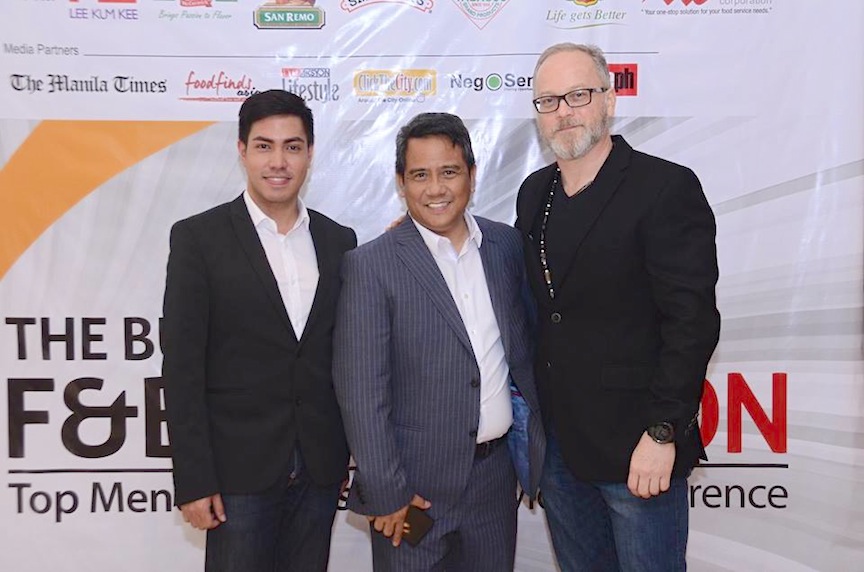
Owning a business in the food and beverage (F&B) industry can be challenging—there is a constant need for creativity, innovation, and relevance, among many others for a brand to successfully thrive.
F&B industry players are usually confronted with hurdles on keeping up with trends, updating menus, and effectively marketing the brand.
With this situation in mind, Courage Asia gathered a powerhouse cast of speakers for a food service conference entitled “The Business of F&B Innovation” held last February at EDSA Shangri-La Hotel in Mandaluyong City.
Speakers during the whole day conference were PR whiz Amor Maclang of GeiserMaclang Communications Group; Gary De Ocampo, CEO of KANTAR/TNS; Miguel Mercado of Ogilvy and Mather; Chef Steven Carl, Co-Owner of the Grind Burger Group; Liquid Chef Kalel Demetrio; Chef Tim Abejuela, Corporate Executive Chef of the Max’s Group; and Margot Torres of McDonald’s Philippines.

Here are some of the important takeaways from the topics presented by the speakers:
Food trends
On his talk entitled, “The Never Ending Menu Innovation: Challenges and Opportunities,” The Grind Burger Group’s Chef Steven Carl shared that keeping up with food trends is a must in innovating your menu.
“Know the latest trends. Your customers are more educated now than they have ever been. The internet has every answer out there that you can imagine. Everybody’s cellphone is the world’s greatest encyclopedia, and it’s all right there in their fingertips. They’re going to know so you better know,” Carl said.
According to Carl, here are some of the food that became popular that have been around the last year or so or are projected to be top trends in 2017: comfort food; global food; Filipino food; dishes that are fire-roasted, smoked, or pickled; organic and premium food; raw food especially poke and seaweed; Buddha bowls; tacos; shareable food; and ‘Insta-ready’ food.
Moreover, Carl shared that healthy snacks, cocktails that have low or no alcohol will continue to be a trend; and the use of technological solutions such as sous vide, pacojet, thermomix, and smoking gun will be explored. On the other hand, the use of refined sugar and refined wheat products will continue to be challenged by other alternatives such as the use of natural sweeteners.
Know your identity
In innovating your menu, it is vital to align it with your identity as a restaurant or as a brand.
Tim Abejuela, Max’s Group of Restaurants’ corporate head chef shared, “Your products should be calibrated with what your restaurant is about. If your product is not aligned with who you are about, it’s likely not to succeed. Everything that you do, everything that you put in a plate needs to say the same message even without them knowing how we are positioning ourselves. It needs to be clear on the dishes that we put out. Without using anything, without me telling or hinting you what we are about, you should see it in the plate.”
Knowing which dishes sell well in your menu also helps you to pinpoint which items to retain or improve.
Citing an example in their restaurant, Carl said it is important to know your unique and defining menu items. In their case, their “hero item” is the burger, therefore, they are going to remain authentic to that, and look for other menu items thay can innovate on.
Information gathering and organizing
Information-gathering, organizing, and storing also applies in doing your menu.
Sharing how he does it, Carl said, “I like to gather all the information I can from the internet, feedback from guests, cookbooks, etc., then make notes; and organize by ideas together by flavor and have the flavors go in together.”
Collaborating with other chefs to put your ideas in place is also advisable.
“Have your chefs work on it individually, and come back and try things against each other. Have everybody gather together, and ‘ideate’ together, and come up with something that you want to try as a group,” Carl shared.
Developing ideas ahead of time, and not only when they are needed can be helpful, according to Abejuela.
He said, “It is important to realize that not all items are stars, and that’s okay. Usually, in myexperience, products don’t come up well when rushed so I develop ideas and concepts way ahead of time. When I have an idea, or if i don’t need it yet, I write it down, expound on it, shelf it, and wait until I can use it.”
Not all crazy ideas are good
While extraordinary ideas can turn into breakthroughs, not all crazy ideas turn out for the better.
For Carl, ideas should have sense and a purpose.
“Innovation and common sense in decisions should go hand in hand. It has to make sense. You can’t just run out there, and create something because it’s crazy and it just looks cool. That’s not going to work. It has to have a purpose,” he said.
For Abejuela on the other hand, practicing restraint is beneficial.
“Don’t go overboard with your ideas, and all these crazy new things just for the sake of it. Think about the dish, your customers, your vision, and I tell you, the result will be more balanced and refined,” Abejuela said.

Give importance to your people
Motivating your people can lead to your restaurant’s or brand’s success.
“Find what works for your team. It will help them keep motivated, and help keep them excited,” Carl shared.
“Find new ways to engage your team. Some of the best employees I’ve ever had were traditional square pegs on round holes. They don’t fit in somewhere, thefore, they were underperforming. Find a way to get that person motivated, and you’ll never know you’ve made one of your best employees,” he added.
For French Baker owner Johnlu Koa, successfully training your employees can lead to rewards including good financial results in the long run.
“If you cannot train people, if you do not have the discipline, if you do not know how to train people, your growth and innovation will be shortlived,” Koa said.
“This continues to be the most challenging part of the business. However, if we motivate people to run our show, I think we can have good financial results and rewards,” he added.
The alphabet of digital marketing
Margot Torres of McDonald’s Philippines highlighted the importance of digital marketing in the F&B industry today.
Apart from millennials, a new generation of tech-savvy consumers are emerging: the Generation Z, who were born in 1995 and onwards, and are considered as “digital natives.”
“They’re very self-aware, quite self-reliant as well. They’re technology innate. When they were born, the internet was already there. They do not know life without the internet, so it is a totally different lifestyle. They are used to four to five screens. They communicate with images, this is a video generation. Social media to them is really a way to connect. These babies, they probably hardly watch TV; and they’re really on Youtube,” Torres shared, describing the lifestyle of generation Z.
“Millenials account for about 25% of our population. They’re 22 to 35 years old today. Digital natives account 30% of that. So, that’s already more than half (of the young population) with huge purchasing power,” Torres shared.
For easy recall, Torres classified the things a digital native is looking for in a brand:
A for Authenticity. Digital natives want authenticity. Authenticity really is about the brand that stays true to its values. Authenticity also is when you’re up against a challenging crisis, you are still truthful.
E for Engagement. They want to be engaged in your brand. They want to be engaged with what is trending or what is the latest.
I for Immersion. Digital natives really want to experience your brand in new ways. They live for experiences not for material things. They appreciate brands that really invite them into the world of that brand, and immerse them that way.
O for Omnipresence. Omnipresence means you are reachable, accessible, not just through your physical restaurant, but also online, any commerce site or, just everywhere across the screens.
U for Utility. Torres encourages entrepreneurs to utilize the many digital platforms available today. She the McDonald’s delivery app. There are many ways to use technology in each of your restaurants to offer. Like the delivery app, it is something useful for customers.
On June 28 at the Edsa Shangrila Hotel, Courage Asia will hold its second Philippine Restaurant Investment Conference. Speakers include topnotch practitioners in the industry. For more details, check Courage Asia’s Facebook page.









